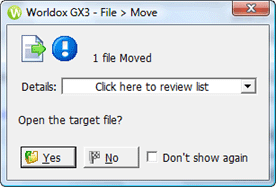The File > Move dialog presents a series of fields and choices used to re-profile moved files.
Tip: Here is a guided tour of a similar profile form (the File Save dialog), detailing fields, information and options presented. |
What appears on the form reflects both your specific user rights and any profiling choices made so far.
Note: Most fields here will be pre-filled as the dialog opens, based on the existing document profile.
To fill out the File > Move form:
The large list field on the right side of
the form shows quick profiles
available for saving files. Tabs organize these choices into Public
and My Profiles. To load a quick
profile, highlight one and click Load Quick Profile Template ![]() . Left-side buttons and fields then change
to reflect the unique combination of settings saved for that quick profile.
. Left-side buttons and fields then change
to reflect the unique combination of settings saved for that quick profile.
Note: You
can add
or change quick profiles - saving completed profiles as new quick
profiles and managing existing quick profile choices - via the Quick Profile
menu ![]() button at the top of the form.
button at the top of the form.
Tip:
The other helpful shortcut is to copy
profile information from an existing document. Click Same
profile as |
Add a document description (or change it) in the Description field.
Note: If you are profiling more than one document, the Description field does not appear. In that case, Worldox assigns descriptions based on existing file names.
Change profile group (optional).
Assuming you have access to multiple profile groups, you can select another group by clicking Profile Group. That opens the Select Profile Group dialog, where you can choose another. If you do change the profile group, the File > Move dialog reloads to display profile fields associated with the selected group.
Fill out profile fields.
To: |
Do this: |
Enter a code or value. |
Type the code in the open profile field. |
Select a code you have used previously. |
Click
|
Select from the list of all valid entries for the field. |
Click the named profile field button; that opens the field table dialog, where you can double-click an item to select it. |
See Working with field tables for details on selecting and searching within field table dialogs.
Colored prompts appear to the right of profile fields. Worldox points out required fields, and checks each entry. Valid choices appear in another color, and invalid or unknown entries are flagged. Here valid choices display in green, while unknown entries and prompts display in red. (You could also see information prompts in a third color, not shown here.)

Tip: Field prompt colors, as with so many other display options in Worldox, can be customized to your taste. |
Add or change comments (optional).
Enter or change comments in the Add'l Comments field. As soon as you start typing in the Comments field, it expands:

Add Below is pre-selected, meaning Worldox will add any new comments below earlier ones (as seen here, on the Comments document tab and in worklists). Select Add Above to have Worldox add new comments above earlier ones, or Replace to always have the last comment added be the only comment saved.
Type in your comment, or click Insert Keyword to add a pre-defined keyword, in the Comment Keywords dialog.
TIP: To add a short, pre-defined comment, place your cursor in the Add'l Comments field, then press F2. That opens the Comment Keywords dialog. |
Click Apply Comments to apply this comment to the profile. Or, click Undo Changes to close this expanded field and leave the Add'l Comments field unchanged.
To spell-check
Description or Add'l
Comments field entries, click
the spell check ![]() icon. That opens the Check
Spelling dialog.
icon. That opens the Check
Spelling dialog.
The Keep Same as Source choice will most likely be pre-selected. If you leave this unchanged, Worldox re-uses the original Doc ID for the moved document. If you select Assign Autoname, Worldox automatically generates a new Doc ID number.
Note: The presence or absence of the Doc ID choice is determined by configuration settings at your site. If you do not see this option on your File > Move dialog, your site does not use it.
Click Move to move the re-profiled document.
![]() Next steps:
Next steps:
The Worldox Check Spelling dialog may appear at this point if Description or Add'l Comments field entries are incorrectly spelled or use words not in the current spelling dictionary.
Worldox then confirms the move, showing you the File > Move confirm dialog.

Here you have the option to review the completed move. Just click the drop down arrow to the right of the Details field. Then click anywhere in the field to close it again.

If only one file has been moved, Worldox asks if you want to open the moved file.
• Click Yes to open the document you just moved and close this dialog.
• Or, click No to close this confirm dialog.
Note: If you moved multiple files, there is no choice to open moved files. An OK button would appear here instead.
Finally, if you do not want to see such messages again after moving files, check the Don't show again box. before closing the dialog.
Once the File > Move profile form is saved, your document has been successfully moved and re-profiled.